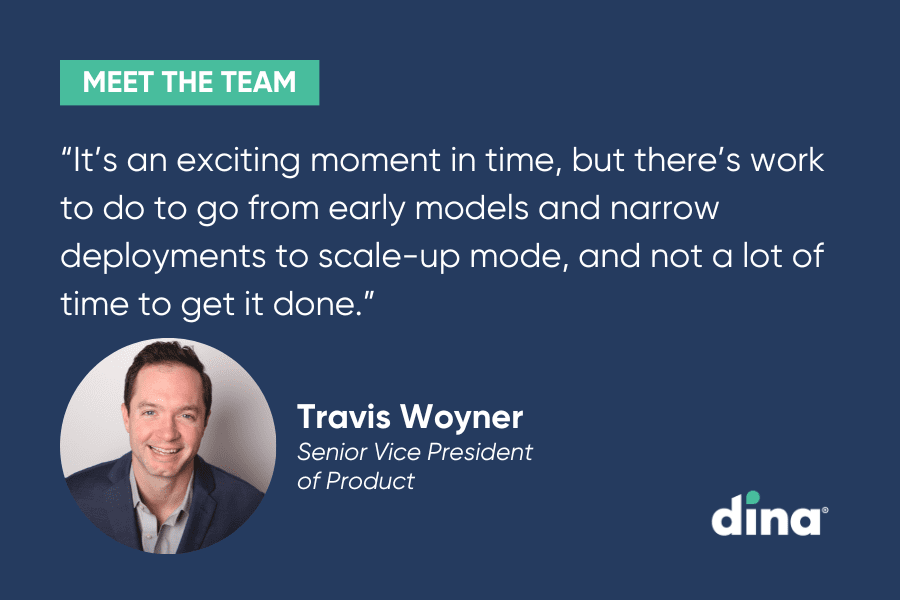
CMS has proposed regulatory requirements for supplemental benefits in 2025 that will demand a new approach from Medicare Advantage plans. And with recent legislative progress, some changes are increasingly close to a reality.
With an eye on the ever-evolving health plan compliance landscape and growing expectations of accessible care, Travis Woyner, Dina’s head of product, explains why the time is right to prepare for change, and why the team is excited for the road ahead.
What trends are you watching that impact health plans and members?
We’re seeing three big trends:
- Consumer preference for easy access to benefits and a desire to self-direct services. Progressive health plans should be thinking in this direction and considering not only the mechanism – whether it is a platform, a member services line, or pre-loaded card – but the process that wraps around the mechanism.
- Contracts are shifting from transactional to value-based. With MLR challenges on the rise, plans are thinking about how to become more operationally efficient, get the right services to the right members, and find the right partnerships to de-risk their environments.
- Transparency around access and utilization. CMS is signaling heightened requirements on data sharing and reporting in order to measure how supplemental benefits are being utilized. Additionally, as the payment source, they are expecting to see an impact on outcomes.
Tell us more about the impact of proposed changes from CMS.
CMS is making it clear that they are expecting a return on taxpayer dollars being spent on benefits and services. Regulation is coming to government programs and it will phase in transparency around utilization, access, and value. We’re seeing the start with progress on FY 2025 rule-making and CMS’s recent note on supplemental benefit data sharing. It’s an exciting moment in time, but there’s work to do to go from early models and narrow deployments to scale-up mode, and not a lot of time to get it done.
How does technology fit into the picture?
Similarly to the provider ecosystem, plans need to think about their anchor system of record and the web of connectivity that extends from it. Plans will continue to lean in on great case management, utilization management, and provider network management systems while increasingly thinking about how to seamlessly extend them with the right vendor plug-ins, care access mechanisms, and supplemental benefit coordination tools.
 To supercharge the experience, plans will commit to automation–helping navigators or coordinators to more effectively organize benefits and services for members – particularly important for plans representing complex members. And of course we see Dina serving a big role here as the vendor and benefit management infrastructure. We’re going to make it easier to access services, and get members the non-medical home care and other services to help them stay in their home longer. We know we’re going to save our plan partners coordination time right out of the gate. And then we can pull back the data to show how benefits are being utilized to meet compliance requirements.
To supercharge the experience, plans will commit to automation–helping navigators or coordinators to more effectively organize benefits and services for members – particularly important for plans representing complex members. And of course we see Dina serving a big role here as the vendor and benefit management infrastructure. We’re going to make it easier to access services, and get members the non-medical home care and other services to help them stay in their home longer. We know we’re going to save our plan partners coordination time right out of the gate. And then we can pull back the data to show how benefits are being utilized to meet compliance requirements.What should plans look for in a vendor partner?
Look for partners that have a near-term and long-term value story–what can they help with today, and what can they help with down the road as the industry shifts to value-based contracts.
The near-term criteria should include efficient resourcing – do they quickly, and to a high degree of satisfaction, deliver services to members? Then, do they have signals that their services can contribute to lowered total cost of care in the long-term? Vendors should be able to measure impact and work with you to realize that impact over time, understanding that it won’t show up in the numbers for a year or more
Lastly, look for partners who will share data back with you for early proof points, who will highlight availability, and lean on other tools to show satisfaction and performance in other contexts.
How should plans think about contracting with partners if the eventual goal is value- or outcome-based?
Contracts can be structured to grow over time into a value-based arrangement. There should be a shared belief that increased spend on in-home, supplemental, or preventative benefits will yield total cost of care savings over a longer period of time. As an example, we work towards increased risk-sharing against specific performance milestones, but ensure that our health plan customers realize near-term value via straightforward ROI measurements right out of the gate.
PACE Members Expect Quick Activation of Home-Based Services.
Does Your Plan Deliver?
See how easy it is to streamline access to medical and non-medical
home-centered benefits, support your centers, and quickly measure results.




